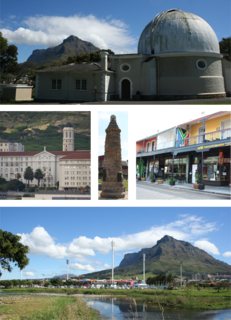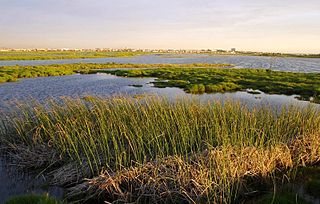| Raapenberg Bird Sanctuary | |
|---|---|
Map of Cape Town | |
| Location | Cape Town, South Africa |
| Nearest city | Observatory |
| Coordinates | 33°56′07″S18°28′48″E / 33.9353°S 18.4799°E Coordinates: 33°56′07″S18°28′48″E / 33.9353°S 18.4799°E [1] |
| Area | 10 ha (25 acres) |
| www | |
Raapenberg Bird Sanctuary is a 10-hectare (25-acre) protected area in Cape Town, located on the Liesbeek river near the suburb of Observatory.

Cape Town is the oldest city in South Africa, colloquially named the Mother City. It is the legislative capital of South Africa and primate city of the Western Cape province. It forms part of the City of Cape Town metropolitan municipality.

Observatory is a suburb in Cape Town, South Africa that is bordered by Mowbray to the south, and Salt River to the northwest. Known affectionately as Obz, the area is best known as a student neighbourhood, most of the students attending the University of Cape Town located close by. It is also the home of the South African Astronomical Observatory headquarters as well as Groote Schuur Hospital.
The sanctuary consists of a section of the Liesbeek River, with parkland, trees, lawn and picnic sites. It is an important breeding site for a variety of water bird species, such as Sacred Ibis ( Threskiornis aethiopicus ), Egyptian Geese ( Alopochen aegyptiacus ) and many duck species. However, the sanctuary is badly overgrown with alien invasive plants which damage the river system and its biodiversity. The river itself is polluted, but is being rehabilitated for recreational activities. [2]

The Liesbeek River is a river in Cape Town in South Africa. It is named after a small river in the Netherlands. The first "free burghers" of the Dutch East India Company were granted land to farm along the river in 1657, shortly after the first Dutch settlers arrived in the Cape. The river was originally called the Amstel or Versse Rivier. It is the first river that Jan van Riebeeck named.

The term water bird, waterbird or aquatic bird is used to refer to birds that live on or around water. Some definitions apply the term especially to birds in freshwater habitats, though others make no distinction from birds that inhabit marine environments. In addition, some water birds are more terrestrial or aquatic than others, and their adaptations will vary depending on their environment. These adaptations include webbed feet, bills and legs adapted to feed in water, and the ability to dive from the surface or the air to catch prey in water.

Biodiversity refers to the variety and variability of life on Earth. Biodiversity is typically a measure of variation at the genetic, species, and ecosystem level. Terrestrial biodiversity is usually greater near the equator, which is the result of the warm climate and high primary productivity. Biodiversity is not distributed evenly on Earth, and is richest in the tropics. These tropical forest ecosystems cover less than 10 percent of earth's surface, and contain about 90 percent of the world's species. Marine biodiversity is usually highest along coasts in the Western Pacific, where sea surface temperature is highest, and in the mid-latitudinal band in all oceans. There are latitudinal gradients in species diversity. Biodiversity generally tends to cluster in hotspots, and has been increasing through time, but will be likely to slow in the future.
The area is intended to form part of the Two Rivers Urban Park (TRUP), which will include many surrounding areas to form a large, integrated natural area in Cape Town. It will centre on the meeting point of the Liesbeek and Black River and will include several Provincial Heritage Sites, such as:
- the South African Astronomical Observatory (1827),
- Valkenberg Homestead (1830)
- Valkenberg Hospital (1899)
- The Nieuwe Molen Windmill
- The Oude Molen Farmhouse complex

South African Astronomical Observatory (SAAO) is the national centre for optical and infrared astronomy in South Africa. It was established in 1972. The observatory is run by the National Research Foundation of South Africa. The facility's function is to conduct research in astronomy and astrophysics. The primary telescopes are located in Sutherland, which is 370 kilometres (230 mi) from Observatory, Cape Town, where the headquarters is located.

The Valkenberg Hospital is a large, government-funded, tertiary psychiatric hospital in the city of Cape Town, South Africa.













